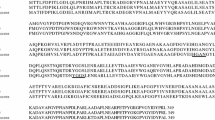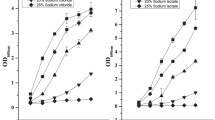Abstract
We recently reported that a strain of the non-pathogenic bacterial species Pseudomonas chlororaphis was capable of producing the biosurfactant molecule, rhamnolipids. Previous to this report the organisms known to produce rhamnolipids were almost exclusively pathogens. The newly described P. chlororaphis strain produced rhamnolipids at room temperature in static minimal media, as opposed to previous reports of rhamnolipid production which occurred at elevated temperatures with mechanical agitation. The non-pathogenic nature and energy conserving production conditions make the P. chlororaphis strain an attractive candidate for commercial rhamnolipid production. However, little characterization of molecular/biochemical processes in P. chlororaphis have been reported. In order to achieve a greater understanding of the process by which P. chlororaphis produces rhamnolipids, a survey of proteins differentially expressed during rhamnolipid production was performed. Separation and measurement of the bacteria’s proteome was achieved using Beckman Coulter’s Proteome Lab PF2D packed column-based protein fractionation system. Statistical analysis of the data identified differentially expressed proteins and known orthologues of those proteins were identified using an AB 4700 Proteomics Analyzer mass spectrometer system. A list of proteins differentially expressed by P. chlororaphis strain NRRL B-30761 during rhamnolipid production was generated, and confirmed through a repetition of the entire separation process.



Similar content being viewed by others
References
Banat IM, Makkar RS, Cameotra SS (2000) Potential commercial applications of microbial surfactants. Appl Microbiol Biotechnol 53:495–508
Bollinger N, Hassett DJ, Iglewski BH, Costerton JW, McDermott TR (2001) Gene expression in Pseudomonas aeruginosa: evidence of iron override effects on quorum sensing and biofilm-specific gene regulation. J Bacteriol 183:1990–1996
Desai JD,Banat IM (1997) Microbial production of surfactants and their commercial potential. Microbiol Mol Biol Rev 61:47–64
Guerra-Santos L, Kappeli O, Fiechter A (1984) P. aeruginosa biosurfactant production in continuous culture with glucose as carbon source. Appl Environ Microbiol 48:301–305
Guerra-Santos LH, Kappeli O, Fiechter A (1986) Dependence of P. aeruginosa continuous culture biosurfactant production on nutritional and enviromental factors. Appl Microbiol Biotechnol 24:443–448
Gunther NW4, Nunez A, Fett W, Solaiman DK (2005) Production of rhamnolipids by Pseudomonas chlororaphis, a nonpathogenic bacterium. Appl Environ Microbiol 71:2288–2293
Hanna SL, Sherman NE, Kinter MT, Goldberg JB (2000) Comparison of proteins expressed by P. aeruginosa strains representing initial and chronic isolates from a cystic fibrosis patient: an analysis by 2-D gel electrophoresis and capillary column liquid chromatography-tandem mass spectrometry. Microbiology 146(Pt 10):2495–2508
Haussler S, Nimtz M, Domke T, Wray V, Steinmetz I (1998) Purification and characterization of a cytotoxic exolipid of Burkholderia pseudomallei. Infect Immun 66:1588–1593
Heurlier K, Denervaud V, Pessi G, Reimmann C, Haas D (2003) Negative control of quorum sensing by RpoN (sigma54) in P. aeruginosa PAO1. J Bacteriol 185:2227–2235
Jarvis FG, Johnson MJ (1949) A glyco-lipid produced by P. aeruginosa. J Am Chem Soc 71:4124–4126
Lang S, Wullbrandt D (1999) Rhamnose lipids—biosynthesis, microbial production and application potential. Appl Microbiol Biotechnol 51:22–32
Maier RM, Soberon-Chavez G (2000) P. aeruginosa rhamnolipids: biosynthesis and potential applications. Appl Microbiol Biotechnol 54:625–633
Mulligan CN (2005) Environmental applications for biosurfactants. Environ Pollut 133:183–198
Ochsner UA, Fiechter A, Reiser J (1994) Isolation, characterization, and expression in Escherichia coli of the P. aeruginosa rhlAB genes encoding a rhamnosyltransferase involved in rhamnolipid biosurfactant synthesis. J Biol Chem 269:19787–19795
Ochsner UA, Reiser J (1995) Autoinducer-mediated regulation of rhamnolipid biosurfactant synthesis in P. aeruginosa. Proc Natl Acad Sci USA 92:6424–6428
Rahim R, Ochsner UA, Olvera C, Graninger M, Messner P, Lam JS, Soberon-Chavez G (2001 ) Cloning and functional characterization of the P. aeruginosa rhlC gene that encodes rhamnosyltransferase 2, an enzyme responsible for di-rhamnolipid biosynthesis. Mol Microbiol 40:708–718
Sauer K, Camper AK, Ehrlich GD, Costerton JW, Davies DG (2002) P. aeruginosa displays multiple phenotypes during development as a biofilm. J Bacteriol 184:1140–1154
Siegmund I, Wagner F (1991) New method for detecting rhamnolipids excreted by Pseudomonas species during growth on mineral agar. Biotechnol Tech 5:265–268
Silberbach M, Schafer M, Huser AT, Kalinowski J, Puhler A, Kramer R, Burkovski A (2005) Adaptation of corynebacterium glutamicum to ammonium limitation: a global analysis using transcriptome and proteome techniques. Appl Environ Microbiol 71:2391–2402
Skalnikova H, Halada P, Dzubak P, Hajduch M, Kovarova H (2005) Protein fingerprints of anti-cancer effects of cyclin-dependent kinase inhibition: identification of candidate biomarkers using 2-D liquid phase separation coupled to mass spectrometry. Technol Cancer Res Treat 4:1–7
Soberon-Chavez G, Aguirre-Ramirez M, Sanchez R (2005) The P. aeruginosa RhlA enzyme is involved in rhamnolipid and polyhydroxyalkanoate production. J Ind Microbiol Biotechnol
Soldi M, Sarto C, Valsecchi C, Magni F, Proserpio V, Ticozzi D, Mocarelli P (2005) Proteome profile of human urine with two-dimensional liquid phase fractionation. Proteomics 5:2641–2647
Thompson LS, Webb JS, Rice SA, Kjelleberg S (2003) The alternative sigma factor RpoN regulates the quorum sensing gene rhlI in P. aeruginosa. FEMS Microbiol Lett 220:187–95
Totten PA, Lara JC, Lory S (1990) The rpoN gene product of P. aeruginosa is required for expression of diverse genes, including the flagellin gene. J Bacteriol 172:389–396
Vallet I, Diggle SP, Stacey RE, Camara M, Ventre I, Lory S, Lazdunski A, Williams P, Filloux A (2004) Biofilm formation in P. aeruginosa: fimbrial cup gene clusters are controlled by the transcriptional regulator MvaT. J Bacteriol 186:2880–2890
Zhang Y, Miller RM (1992) Enhanced octadecane dispersion and biodegradation by a Pseudomonas rhamnolipid surfactant (biosurfactant). Appl Environ Microbiol 58:3276–3282
Zheng S, Schneider KA, Barder TJ, Lubman DM (2003) Two-dimensional liquid chromatography protein expression mapping for differential proteomic analysis of normal and O157:H7 Escherichia coli. Biotechniques 35:1202–1212
Acknowledgments
We thank John Phillips for his expert assistance with the statistical analysis of this project’s data.
Author information
Authors and Affiliations
Corresponding author
Additional information
Mention of trade names or commercial products in this publication is solely for the purpose of providing specific information and does not imply recommendation or endorsement by the U.S. Department of Agriculture.
Rights and permissions
About this article
Cite this article
Gunther , N.W., Nuñez, A., Fortis, L. et al. Proteomic based investigation of rhamnolipid production by Pseudomonas chlororaphis strain NRRL B-30761. J Ind Microbiol Biotechnol 33, 914–920 (2006). https://doi.org/10.1007/s10295-006-0169-1
Received:
Accepted:
Published:
Issue Date:
DOI: https://doi.org/10.1007/s10295-006-0169-1




